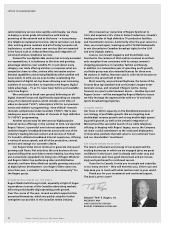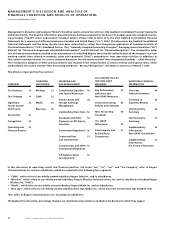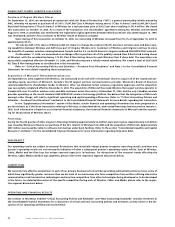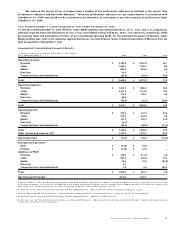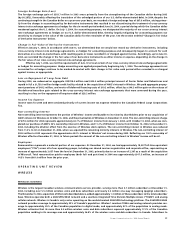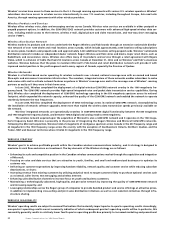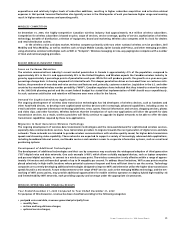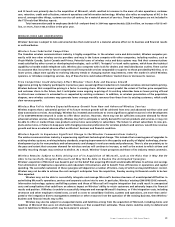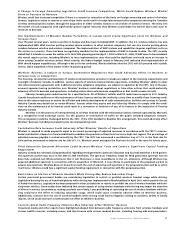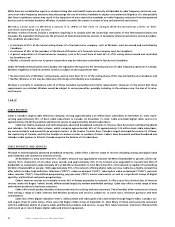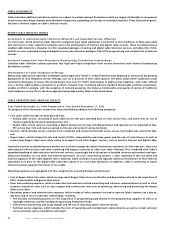Rogers 2004 Annual Report Download - page 26
Download and view the complete annual report
Please find page 26 of the 2004 Rogers annual report below. You can navigate through the pages in the report by either clicking on the pages listed below, or by using the keyword search tool below to find specific information within the annual report.
24 Rogers Communications Inc. 2004 Annual Report
Wireless’ services have access to these services in the U.S. through roaming agreements with various U.S. wireless operators. Wireless’
subscribers also have access to wireless service internationally in over 170 countries, including throughout Europe, Asia and Latin
America, through roaming agreements with other wireless providers.
Wireless Products and Services
Wireless offers wireless voice, data and messaging services across Canada. Wireless voice services are available in either postpaid or
prepaid payment options. In addition, the GSM/GPRS/EDGE network provides customers with advanced high-speed wireless data ser-
vices, including mobile access to the Internet, wireless e-mail, digital picture and video transmission, and two-way short messaging
service (“SMS”).
Wireless Distribution Network
Wireless markets its products and services under both the Rogers Wireless and Fido brands through an extensive nationwide distribu-
tion network of over 7,000 dealer and retail locations across Canada, which include approximately 2,000 locations selling subscriptions
to service plans, handsets and prepaid cards and approximately 5,000 additional locations selling prepaid cards. Wireless’ nationwide
distribution network includes an independent dealer network, Rogers Wireless and Fido stores and kiosks, major retail chains, such as
RadioShack, and convenience stores. Wireless also offers many of its products and services through a retail agreement with Rogers
Video, which is a division of Cable that had 294 locations across Canada at December 31, 2004, and on Wireless’ and Fido’s e-business
websites. Wireless believes that the plans to maintain Microcell’s Fido brand and retail distribution network will provide it with
improved market position in the youth segment and in many regions of Canada, especially the Province of Quebec.
Wireless Networks
Wireless is a facilities-based carrier operating its wireless networks over a broad, national coverage area with an owned and leased
fibre-optic and microwave transmission infrastructure. The seamless, integrated nature of these networks enables subscribers to make
and receive calls and to activate network features anywhere in Wireless’ coverage area and in the coverage area of Wireless’ roaming
partners as easily as if they were in their home area.
In June 2002, Wireless completed the deployment of a digital wireless GSM/GPRS network overlay in the 1900 megahertz fre-
quency band. The GSM/GPRS network provides high-speed integrated voice and packet data transmission service capabilities. During
2003, Wireless also completed the deployment of GSM/GPRS technology operating in the 850 megahertz spectrum across its national
footprint, which expanded the network capacity, enhanced the quality of the GSM/GPRS network and enabled the network to operate
seamlessly between the two frequencies.
In June 2004, Wireless completed the deployment of EDGE technology across its national GSM/GPRS network. Accomplished by
the installation of network software upgrades, EDGE more than tripled the wireless data transmission speeds previously available on
the network.
Wireless’ integrated networks are operationally seamless in GSM/GPRS/EDGE digital functionality between the 850 megahertz
and 1900 megahertz frequency bands, and between TDMA digital and analog modes at 850 megahertz.
The wireless network acquired upon the acquisition of Microcell is also a GSM/GPRS network and it operates on the 1900 mega-
hertz frequency band. Wireless is presently in the process of integrating the Rogers Wireless and Microcell GSM/GPRS networks.
Following the Microcell acquisition, Wireless holds 25 megahertz of contiguous spectrum across Canada in the 850 frequency range and
60 megahertz in the 1900 frequency range across the country with the exception of Southwestern Ontario, Northern Quebec, and the
Yukon, NWT and Nunavut territories where it holds 50 megahertz in the 1900 frequency range.
WIRELESS STRATEGY
Wireless’ goal is to achieve profitable growth within the Canadian wireless communications industry, and its strategy is designed to
maximize its cash flow and return on investment. The key elements of the Wireless strategy are as follows:
• Enhancing its scale and competitive position in the Canadian wireless communications market through the acquisition and integration
of Microcell;
• Focusing on voice and data services that are attractive to youth, families, and small and medium-sized businesses to optimize its
customer mix;
• Delivering on customer expectations by improving handset reliability, network quality and customer service while reducing subscriber
deactivations, or churn;
• Increasing revenue from existing customers by utilizing analytical tools to target customers likely to purchase optional services such
as voicemail, caller line ID, text messaging and wireless Internet;
• Enhancing sales distribution channels to increase focus on youth and business customers;
• Maintaining a technologically advanced, high-quality and pervasive network by improving the quality of GSM/GPRS/EDGE network
and increasing capacity; and
• Leveraging relationships across the Rogers group of companies to provide bundled product and service offerings at attractive prices,
in addition to implementing cross-selling and joint sales distribution initiatives as well as cost reduction initiatives through infra-
structure sharing.
WIRELESS SEASONALITY
Wireless’ operating results are subject to seasonal fluctuations that materially impact quarter-to-quarter operating results. Accordingly,
one quarter’s operating results are not necessarily indicative of what a subsequent quarter’s operating results will be. In particular, this
seasonality generally results in relatively lower fourth quarter operating profits due primarily to increased marketing and promotional




